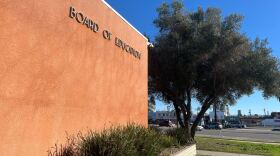Officials with the San Diego Association of Governments (SANDAG) regional planning agency are seeking public input on a draft transportation plan that maps out infrastructure investments over the next 25 years.
The 2025 Regional Transportation Plan is significantly smaller in scope than the previous plan adopted in 2021. Antoinette Meier, SANDAG's senior director of regional planning, said part of the reason is slower population growth, which means planning for fewer people.
"We also want to have this plan be a little bit more affordable," Meier said. "We heard from our board, we heard from the public that they wanted the costs to come down for the plan. So we tried to really optimize our existing infrastructure the best we could."
A KPBS review of the draft found roughly 93 miles of new "managed lanes," which are typically open to carpools, buses and toll-paying solo drivers, at a combined cost of $2.1 billion. Another 259 miles of managed lanes would be created by converting existing HOV or general purpose lanes, also costing roughly $2.1 billion.
An earlier version of the draft plan included more than twice as many miles of added freeway lanes. Decades of research has found adding capacity for more vehicles on freeways does not reduce congestion in the long term, but does increase driving and greenhouse gas emissions. State law requires SANDAG to adopt a plan that would achieve a 19% reduction in those emissions by 2035.
"We're trying not to expand freeways, so wherever we can, we're going to be using the existing right-of-way to add managed lanes," Meier said.
SANDAG is accepting public comments on its draft plan through July 18. The SANDAG board of directors must officially adopt the plan by the end of the year to continue receiving state and federal transportation dollars.
The plan counts on voters approving three new sales taxes — one sponsored by the Metropolitan Transit System in 2028, which would fund public transit improvements, and two others in 2032 and 2036, which would fund a mix of transit, highway and bike projects. It also assumes parking fees will be used to fund smaller-scale neighborhood shuttles.
SANDAG staff held a community workshop on the draft plan in City Heights on Thursday. In attendance was KC Gupta, executive director of the People's Platform San Diego, a youth-led movement to fight climate change by investing in public transit.
The group has launched a campaign urging SANDAG to reprogram $22.5 million in funding to study highway projects, which it says are not guaranteed to actually get built. Instead, the group supports using those funds to immediately increase bus and trolley frequencies and make other improvements to existing transit services.
Gupta said he supports SANDAG's near-term investments in rapid bus lines, but that even existing routes are not as fast or frequent as originally promised. The Rapid 215 bus from SDSU to downtown San Diego, he said, can hardly be considered "rapid."
"What we got was a route no faster than the route it replaced," Gupta. "(The city of) San Diego had to pay for the bus lanes, and we never got all-door boarding. So SANDAG has promised us a lot in the past, but they haven't delivered on their promises."







